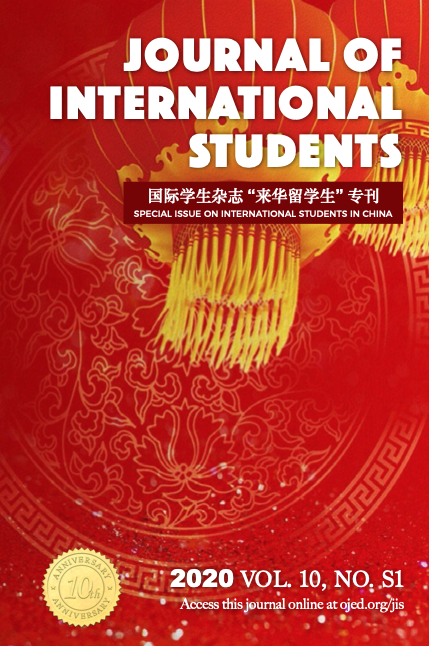Why did Engineering Students Choose to Study in China? 工科学生缘何来华留学
DOI:
https://doi.org/10.32674/jis.v10iS(3).1769Keywords:
工科学生,留学中国,择校过程,质性研究Abstract
China is currently the third-largest destination country for international students in the world. Among the international students in China, the number of those in engineering schools is increasing most rapidly. Based on the “Push-Pull” theory (Altbach, 1998) and a three-stage decision-making theory (Ma, 2017), this research explored the factors influencing international students’ choices of engineering schools in China. Twenty-two international students in engineering schools at a leading Chinese university were interviewed. Qualitative analyses of the interview data suggested that the participants were attracted to China by the availability of scholarships, ranking of the host university, and opportunities for personal growth and professional development. Meanwhile, it was found that positive relationships between the students’ home countries and China, inadequate educational and research resources in home countries, and higher tuition fees and educational costs involved in studying in Western countries also influenced their decision-making process. 中国已经成为全球第三大留学目的国,其工科留学生数量增速最快、位居所有学科第二。本研究基于囊括宏观因素与微观因素的“推拉”理论和国际学生择校三阶段理论的指导,采用质性研究方法,以S校为研究平台,一对一地访谈了来自亚、欧、美、非洲的22名工科学生,旨在探索形成工科学生来华留学“热潮”的原因。研究发现,可获得的奖学金、雄厚的工科实力、促进个人发展是影响他们来华留学的主要因素,友好的两国关系、母国教育与研究资源的匮乏、西方国家昂贵的留学费用在择校过程中也起到了一定作用。
References
Chao, C., Hegarty, N., Angelidis, J., & Lu, V. F. (2017). Chinese students’ motivations for studying in the United States. Journal of International Students, 7(2), 257-269.
Chen, L. H. (2007). Choosing Canadian graduate schools from afar: East Asian students’ perspectives. Higher Education, 54(5), 759-780.
Chen, T. M., & Barnett, G. A. (2000). Research on international student flows from a macro perspective: A network analysis of 1985, 1989 and 1995. Higher education, 39(4), 435-453.
De Wit, H., & Altbach, P. G. (2018). Dramatic instability in international higher education. Retrieved October 10, 2019 from http://www.insidehighered.com/blogs/world-view/dramatic-instability-international-higher-education
Ding, X. (2016). Exploring the experiences of international students in China. Journal of Studies in International Education, 20(4), 319-338.
Institute of International Education. (2015-2018). Global mobility trends. Retrieved October 10, 2019 from https://www.iie.org/Research-and-Insights/Project-Atlas/Explore-Data
Lee, E. S. (1966). A theory of migration. Demography, 3(1),47-57.
Lu, G., & Tian, M. (2018). An analysis of factors influencing international students’ choice of education in China. In F. Dervin, X. Du, & A. Härkönen (Eds.), International Students in China: Education, Student Life and Intercultural Encounters (pp. 15-46). Cham, Switzerland: Palgrave Macmillan.
Ma, J. (2017). Why and how international students choose Mainland China as a higher education study abroad destination. Higher Education, 74(4), 563-579.
Mazzarol, T., & Soutar, G. N. (2002). “Push-pull” factors influencing international student destination choice. International Journal of Educational Management, 16(2), 82-90.
Nghia, T. L. H. (2019). Motivations for Studying Abroad and Immigration Intentions. Journal of International Students, 9(3), 758-776.
Organization for Economic Co-operation and Development. (2018). What is the profile of internationally mobile students?. Retrieved from http://www.oecd.org/education/education-at-a-glance
Pew Research. (2017). New foreign student enrollment at U.S. colleges and universities doubled since Great Recession. Retrieved from http://www.pewresearch.org/fact-tank/2017/11/20/new-us-foreign-student-enrollment-doubled-since-great-recession
Ruby, A., (2009). The uncertain future for international higher education in the Asia-Pacific Region. Presented at the invitation forum on new approaches to cooperation with Asia and Australia. NAFSA, Association of International Educators Annual Conference. Los Angeles, California.
Strauss, A., & Corbin, J. M. (1990). Basics of qualitative research: Grounded theory procedures and techniques. Thousand Oaks, CA: Sage Publications, Inc.
Wen, W., & Hu, D. (2018). The emergence of a regional education hub: Rationales of international students’ choice of China as the study destination. Journal of Studies in International Education, 23(3), 303-325.
陈强, & 文雯. (2018). “一带一路”倡议下来华留学生教育:使命、挑战和对策. 高校教育管理, 12(3), 28-33.
程伟华, 张海滨, & 董维春. (2019). “双一流”建设背景下来华留学研究生教育质量研究——基于学生发展理论.学位与研究生教育, 314(01), 68-75.
教育部国际合作与交流司. (2003-2018). 2002-2017来华留学生简明统计. 北京: 教育部国际合作与交流司.
李立国, 陈岚, & 赫文婧. (2015). 为什么留学中国? --以中国人民大学留学生调查为例. 复旦教育论坛, 13 (1), 37-43.
宋华盛, &刘莉. (2014). 外国学生缘何来华留学--基于引力模型的实证研究. 高等教育研究, 35(11), 31-38.
孙慧莉, & 李忠明. (2017). 来华学历生择校影响因素及择校途径研究--以江苏省为例. 高教探索, (8), 82-89.
吴娴. (2017). 日本高校全英语学位课程的研究及对中国的启示. 清华大学教育研究, 38(6), 81-88.
Downloads
Published
Issue
Section
License

This work is licensed under a Creative Commons Attribution-NonCommercial-NoDerivatives 4.0 International License.
All published articles are licensed under a Creative Commons Attribution-NonCommercial-NoDerivs 4.0 Unported License.















